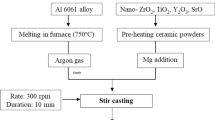Abstract
Present investigation deals with pin-on-disk type of tribometer used to conduct abrasive wear testing of in situ Al–4.5%Cu–xTiB2 composites for enhanced understanding of the physical wear phenomenon. Characterization studies for comprehending ceramic TiB2 reinforcement distribution and wear surface topology analysis of Al–4.5%Cu–xTiB2 composites were executed through field emission scanning electron microscopy, X-ray diffraction, and high-resolution atomic force microscopy techniques. Experimental design based on full factorial method and Taguchi’s orthogonal array has been employed in the study to conduct wear experimental runs and study control parameters that are affecting the wearing phenomenon. Taguchi’s loss function method along with the assistance of MINITAB 17 software was used to optimize various control parameters involved in the experiment. ANOVA method was employed further to identify percentage contribution of various control parameter combinations affecting the output parameters. Furthermore, regression model was developed to assist in calculation of output response parameters based upon the existing wear experimental results. Consequently, this in-depth investigation on wear characteristics can immensely help in understanding the true influence of various parameters and their effects on the wear phenomenon of Al–4.5%Cu–xTiB2 composites.
Graphic abstract













Similar content being viewed by others
References
Sujith S V, Mahapatra M M, and Mulik R S Proc Inst Mech Eng Part J J Eng Tribol 234 (2020) 588. Doi:10.1177/1350650119883559
Aherwar A, Patnaik A, and Pruncu C, J Mater Res Technol 9 (2020) 9882. https://doi.org/10.1016/j.jmrt.2020.07.003.
Iyappan S K, and Ghosh A, Mater Manuf Process 30 (2015) 912. https://doi.org/10.1080/10426914.2014.984212.
Shamim F A, Dvivedi A, and Kumar P, Mater Manuf Process 00 (2020) 1. https://doi.org/10.1080/10426914.2020.1802044.
Sharma S, Nanda T, and Pandey O P, Ceram Int 44 (2018) 104. https://doi.org/10.1016/j.ceramint.2017.09.132.
Gui M, Wang D, Wu J, and Li C, Mater Res Bull 36 (2001) 1573. https://doi.org/10.1016/s0025-5408(01)00485-8.
Mozammil S, Karloopia J, Verma R, and Jha P K, J Alloys Compd 793 (2019) 454. https://doi.org/10.1016/j.jallcom.2019.04.137.
Jayakumar E, Praveen A P, Rajan T P D, Pai B C, Trans Indian Inst Met 71 (2018) 2741. https://doi.org/10.1007/s12666-018-1442-5.
Kumar A, Jha P K, and Mahapatra M M, J Mater Eng Perform 23 (2014) 743. https://doi.org/10.1007/s11665-013-0836-0.
Singh J, and Chauhan A, Ceram Int 42 (2016) 56. https://doi.org/10.1016/j.ceramint.2015.08.150.
Chak V, Chattopadhyay H, and Dora T L, J Manuf Process 56 (2020) 1059. https://doi.org/10.1016/j.jmapro.2020.05.042.
Wäsche R, and Klaffke D, Tribol Int 32 (1999) 197. https://doi.org/10.1016/s0301-679x(99)00033-x.
Kumar S, Chakraborty M, Subramanya Sarma V, Murty B S, Wear 265 (2008) 134. https://doi.org/10.1016/j.wear.2007.09.007.
Arif S, Jamil B, Naim Shaikh M B, Aziz T, Ansari A H, and Khan M, Eng Sci Technol Int J 23 (2020) 674. https://doi.org/10.1016/j.jestch.2019.07.001.
Meena K L, Vidyasagar C S, and Karunakar D B, Trans. Indian Inst. Met. 73 (2020) 1909. https://doi.org/10.1007/s12666-020-02001-y.
Mandal A, Chakraborty M, and Murty B S, Wear 262 (2007) 160. https://doi.org/10.1016/j.wear.2006.04.003.
Bembalge O B, and Panigrahi S K, Ceram Int 45 (2019) 20091. https://doi.org/10.1016/j.ceramint.2019.06.274.
Sun J, Zhang X, Zhang Y, Ma N, and Wang H, Micron 70 (2015) 21. https://doi.org/10.1016/j.micron.2014.12.002.
Shirvanimoghaddam K, Khayyam H, Abdizadeh H, Akbari M K, Pakseresht A H, Abdi F, Abbasi A, and Naebe M, Ceram Int 42 (2016) 6206. https://doi.org/10.1016/j.ceramint.2015.12.181.
Mozammil S, Karloopia J, Verma R, and Jha P K, J Alloys Compd 826 (2020) 154184. https://doi.org/10.1016/j.jallcom.2020.154184.
Mondal D P, Das S, Jha A K, and Yegneswaran A H, Wear 223 (1998) 131. https://doi.org/10.1016/s0043-1648(98)00278-6.
Suresh S, and Moorthi N S V, in Procedia Engineering, 2012: p 89. https://doi.org/10.1016/j.proeng.2012.06.013.
Ramakoteswara V, Ramanaiah N, and Mohiuddin Sarcar M M, J Mater Res Technol 5 (2016) 377. https://doi.org/10.1016/j.jmrt.2016.03.011.
Han Y, Liu X, and Bian X, Compos Part A Appl Sci Manuf 33 (2002) 439.
Mozammil S, Verma R, Karloopia J, and Jha P K, J Mater Res Technol 9 (2020) 8041. https://doi.org/10.1016/j.jmrt.2020.05.045.
Karloopia J, Mozammil S, and Jha P K, JOM 72 (2020) 2927.
Verma R, Nath S K, and Jayaganthan R, J Matlet 285 (2021) 129111. https://doi.org/10.1016/j.matlet.2020.129111.
Verma R, Jayaganthan R, Nath S K, Srinivasan A, J Matchar 160 (2019) 110048. https://doi.org/10.1016/j.matchar.2019.110048.
Acknowledgement
The authors would like to extend their heartfelt appreciations and a deep sense of gratitude to the Department of Mechanical & Industrial Engineering, Indian Institute of Technology, Roorkee, for providing the required facilities throughout the investigation and experiments.
Author information
Authors and Affiliations
Corresponding author
Additional information
Publisher's Note
Springer Nature remains neutral with regard to jurisdictional claims in published maps and institutional affiliations.
Rights and permissions
About this article
Cite this article
Mozammil, S., Koshta, E. & Jha, P.K. Abrasive Wear Investigation and Parametric Process Optimization of in situ Al–4.5%Cu–xTiB2 Composites. Trans Indian Inst Met 74, 629–648 (2021). https://doi.org/10.1007/s12666-020-02180-8
Received:
Accepted:
Published:
Issue Date:
DOI: https://doi.org/10.1007/s12666-020-02180-8




